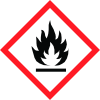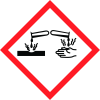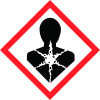tert-Butyl methyl ether
Fisher Scientific
Revision date : 2017-05-26



General Information
Revision date
2017-05-26
Product name
tert-Butyl methyl ether
Product Synonyms
2-Methyl-2-methoxy propane; MTBE; Methyl tert-butyl ether
CAS No.
1634-04-4
Emergency telephone
US 001-201-796-7100 / Europe +32 14 57 52 99
Icons in SDS
Company Information
Company name
Fisher Scientific
GHS Information
Signal word
Danger
Section 2
2.1 Classification of the substance or mixture
This chemical is considered hazardous by the 2012 OSHA Hazard Communication Standard (29 CFR 1910.1200) Flammable liquids Category 2 Skin Corrosion/irritation Category 2 Specific target organ toxicity (single exposure) Category 3 Target Organs - Lungs.
Signal word
Danger
Hazard statements
Highly flammable liquid and vapor Causes skin irritation May cause respiratory irritation
Prevention
Wash face, hands and any exposed skin thoroughly after handling Wear protective gloves/protective clothing/eye protection/face protection Use only outdoors or in a well-ventilated area Keep away from heat/sparks/open flames/hot surfaces. - No smoking Keep container tightly closed Ground/bond container and receiving equipment Use explosion-proof electrical/ventilating/lighting/equipment Use only non-sparking tools Take precautionary measures against static discharge Keep cool Avoid breathing dust/fume/gas/mist/vapors/spray
Response
Get medical attention/advice if you feel unwell Inhalation IF INHALED: Remove victim to fresh air and keep at rest in a position comfortable for breathing Call a POISON CENTER or doctor/physician if you feel unwell Skin If skin irritation occurs: Get medical advice/attention IF ON SKIN (or hair): Take off immediately all contaminated clothing. Rinse skin with water/shower Wash contaminated clothing before reuse Eyes IF IN EYES: Rinse cautiously with water for several minutes. Remove contact lenses, if present and easy to do. Continue rinsing If eye irritation persists: Get medical advice/attention Fire In case of fire: Use CO2, dry chemical, or foam for extinction
Storage
Store in a well-ventilated place. Keep container tightly closed Store locked up
Disposal
Dispose of contents/container to an approved waste disposal plant
Other hazards
Aspiration hazard if swallowed - can enter lungs and cause damage.

